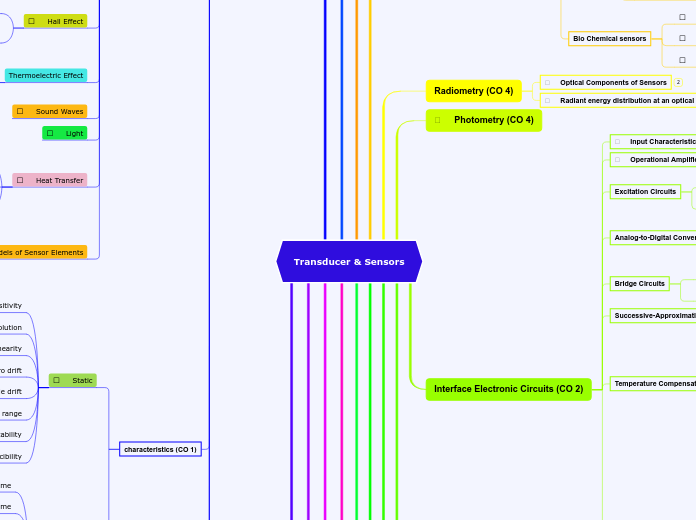
Ultrasonic Detector
Microwave Detector
Microwave occupancy detector
Microwave Doppler motion detector
Capacitive Detector
Capacitive Occupancy Detectors
An automotive capacitive intrusion detector
Capacitive proximity sensor.
Triboelectric Detectors
Monopolar Triboelectric motion detector.
Velocity Sensor
principle of an electromagnetic velocity sensor
Accelerometer Characteristics
accelerometers
Piezoelectric accelerometers
Construction
Principle of Working
Piezoelectric Cables
Construction
Principle of Working
Piezoresistive accelerometers
Construction
Principle of Working
Thermal accelerometers
Heated-Plate Accelerometer
Construction
Subtopic
Heated-Gas Accelerometer
Construction
Principle of Working
Gyroscopes
Rotor Gyroscope
Construction
Principle of Working
Monolithic Silicon Gyroscopes
Construction
Subtopic
Optical Gyroscopes
Construction
Principle of Working
Gravitational Sensors
Conductive gravitational sensors
Construction
Principle of Working
Optoelectronic inclination sensor
Construction
Principle of Working
Classes of Chemical sensors
Chemical Sensor Characteristics
Metal-Oxide Chemical Sensors
Construction
Principle of Working
ChemFET
Construction
Principle of Working
Bio Chemical sensors
Enzyme Sensors
Multisensory Arrays
Electronics Noses and Tongues
Optical Components of Sensors
Radiant energy distribution at an optical plate
Input Characteristics of Interface Circuits
Operational Amplifiers
Excitation Circuits
Current Generators
Voltage References
Analog-to-Digital Converters
Basic Concepts
Dual-Slope Converter
Bridge Circuits
General circuit of a Wheatstone bridge.
Null-Balanced Bridge
Successive-Approximation Converter
Temperature Compensation of Resistive Bridge
Temperature Compensation of Resistive Bridge
General circuit of a bridge temperature compensation
Temperature compensation of a bridge circuit:
(A) with NTC thermistor;
(B) with a fixed resistor;
(C) with a temperature-controlled voltage source;
(D) with a current source
Noise in Sensors and Circuits
Inherent Noise
Transmitted Noise
Mechanical Noise
Seebeck Noise
Shielding
Electric Shielding
Magnetic Shielding
Mechanical Noise
Ground Planes
Ground Loops and Ground Isolation
Two-Wire Transmission
Four-Wire Sensing
Six-Wire Sensing
Primary Cells
Secondary Cells
Types of Temperature Scales
Conversion from Centigrade to Fahrenheit
Conversion from Fahrenheit to Centigrade
Temperature sensors
principle of working
Types
Contact Type
Non-Contact Type
Bimetallic Thermometers
Construction
Types
Helix strip bimetallic thermometer
Spiral strip bimetallic thermometer
Selection criteria
calibration
Advantages and disadvantages
Thermistor
Working
Types
PTC
NTC
Advantages
Disadvantages:
Thermopiles
Working principle
Advantages
Thermocouple
Working principle
Advantages
Calibration Units and relations
Manometers
Manometer basics
Types
U-tube manometer
Barometer
Inclined manometer
Meniscus error
Applications
Fundamental Standards
Standardization of measurement units
Units
Systems
Classification (CO 1)
Resistive Transducers
Capacitance Transducers
Inductance Transducers
Voltage and current Transducers
Self-Generating Transducers
Active Transducers
Sensing Principle (CO 2)
Electric charges, fields
Physical effects
Triboelectric effect
Triboelectric effect
Positive test charge in the vicinity of a charged object
Electric field of a spherical object
Electric field around an infinite line
Near an infinite sheet
A pointed conductor concentrates an electric field
Electric dipole
An electric dipole in an electric field is subjected to a
rotating force
Capacitance
Electric charge and voltage define the capacitance between two objects
A parallel plate capacitor
Cylindrical capacitor
capacitive displacement sensor
Capacitive water level sensor
Magnetism
Electric current sets a circular magnetic field around a conductor.
Faraday’s Law
Solenoid
Toroid
Permanent Magnets
Induction
Mutual inductances in solenoids (A) and in a toroid (B).
Resistance
Specific Resistivity
Temperature Sensitivity
Strain Sensitivity
Moisture Sensitivity
Piezoelectric Effect
Thermal poling of a piezoelectric and pyroelectric material
Piezoelectric Films
Pyroelectric Effect
Working principle
Pyroelectric sensor and its equivalent circuit
Hall Effect
Equivalent circuit of a Hall sensor
Characteristics of a Linear Hall Effect Sensor
Thermoelectric Effect
Seebeck and Peltier Effects
Thermoelectric loop
Sound Waves
Light
Heat Transfer
Thermal Conduction
Thermal Convection
Thermal Radiation
Dynamic Models of Sensor Elements
Mechanical Elements
Thermal Elements
Electrical Elements
characteristics (CO 1)
Static
Sensitivity
Resolution
Linearity
zero drift
full-scale drift
range
repeatability
reproducibility
Dynamic
rise time
delay time
peak time
settling time
percentage error
steady-state error
Advantages of Electrical transducers
Subtopic
Subtopic
Factor to be considered while selecting transducer
Requirements of a good transducers
Construction
Working
Types
Characteristics
Working principle
Pressure sensing elements
Advantages
Disadvantages
Definition
Types
DC Tachometer Generator
Construction
EMF Equation
Advantages & Disadvantages
AC Tachometer Generator
Construction
Advantages & Disadvantages
Optical/Photo Tachometers
Operating Principle
Advantages
Uses
Density of states
one dimensional gas sensors
Nano sensor
Gas sensing with nano structured thin films
Nano Optical Sensor
Nano mechanical sensors
Bio Sensors
Structure of Protein
role of protein in nanotechnology
using protein in nano devices
Antibodies & Antigen
antibodies in sensing
antibody in nano particle conjugates
enzymes
enzymes in sensing
enzyme nano particle
hybrid sensors
Motor proteins in sensing
transmembrane sensors
Bioelectronic sensors
DNA sequencing with nano pores sensors based on molecules with dendritic architectures
Biomagnetic sensors.